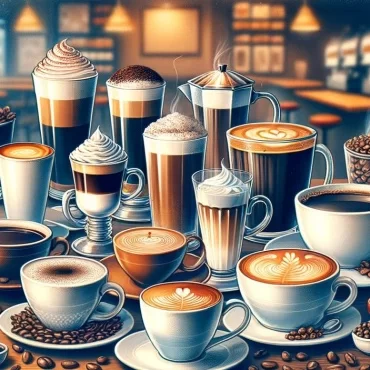
Types of coffee and how to distinguish them
Are you a lover of the bitter aroma of properly roasted coffee beans? Have you fallen for the typical taste of a well-prepared espresso? So have we! But how do you prepare such coffee and what requirements must it meet to boast world-famous names like lungo or ristretto? We will advise you not only on their preparation, but also on the correct proportions of each ingredient, which significantly contribute to the final taste and aroma of the coffee.
Basic Types of Coffee
In cafés, you commonly come across types that require espresso for their preparation. The result differs only in the size of the coffee and the addition of milk or milk foam. Below we have prepared a brief overview of the most basic types of coffee, thanks to which you will not hesitate in a café and will order great coffee on the first try.
What is Espresso Coffee
As we have already mentioned, it is a basic type of coffee, from which the preparation of others is derived. The name is not derived from the speed when you hurry to work, and so you manage to "kick" one espresso and run to the bus. It is a form of preparation - ground coffee is let through a minimum amount of hot water under high pressure.
It is very important to pay attention to the amount of ground coffee. For espresso, it ranges from 7-14 g for 30 ml of almost boiling water (90 °C). The water pouring time should be 30 seconds. The type of coffee also determines the thick foam that forms on its surface.
What is Ristretto Coffee
Espresso ristretto is the most distinctive of the range of coffees and its taste does not suit everyone. Although it is prepared in the same way as espresso from 7-14 g, the volume of ristretto is only 20 ml, half as much. The rich taste can be a bit confusing, as the caffeine content of ristretto is very low - this is because caffeine begins to be released from ground coffee approximately at the moment when espresso already flows into the cup (i.e. when the volume exceeds 20 ml).
If you want to try new coffee flavors that no other will offer you and treat yourself to a cup of delicious taste also on a hot summer day, try ristretto. The more concentrated and stronger taste will open up new horizons for you on how to enjoy a delicious sip full of flavor. Thanks to our instructions, you can prepare ristretto yourself
What is Doppio Coffee
Need a real kick? Have a so-called double shot. This is a double espresso, i.e., a double dose of ground coffee. Specifically, it is prepared from 14-28 g and 60 ml of water. Its volume is larger, as is the caffeine content. Espresso doppio is popular especially for its rich taste experience, which it offers to lovers of strong coffee.
The origin of doppio espresso goes back, of course, to sunny Italy, where it is a reaction of café visitors to the demand for strong coffee, which gives you energy especially in the morning or during a demanding day. Baristas noticed frequent orders of double the amount of espresso, so they had no choice but to offer customers what their taste buds desired. Prepare a cup of strong taste yourself thanks to our detailed instructions.
What is Lungo Coffee
In cafés, you can also encounter it under the term long coffee or "long". Espresso lungo lies in the extraction of 7-14 g of ground coffee together with hot water. The volume of lungo is 60 ml, the same as doppio, but poorer by one dose of espresso. Its final taste is milder and more bitter compared to others, precisely because of the larger amount of water. In most cafés, it works so that you get a cup of coffee with a volume of 30 ml on the table and you determine the taste experience of espresso lungo yourself with another jug of hot water.
Coffee lovers will appreciate it especially for its less pronounced taste, unlike espresso, precisely because it is adjusted with water. If you like to treat yourself to a proper cup of aromatic coffee and espresso is too strong for you, reach for lungo coffee. We have written detailed instructions for its preparation on our website.
Not All Coffee is the Same
Why doesn't your home-prepared coffee taste like the one you have in your favorite café?


























































































